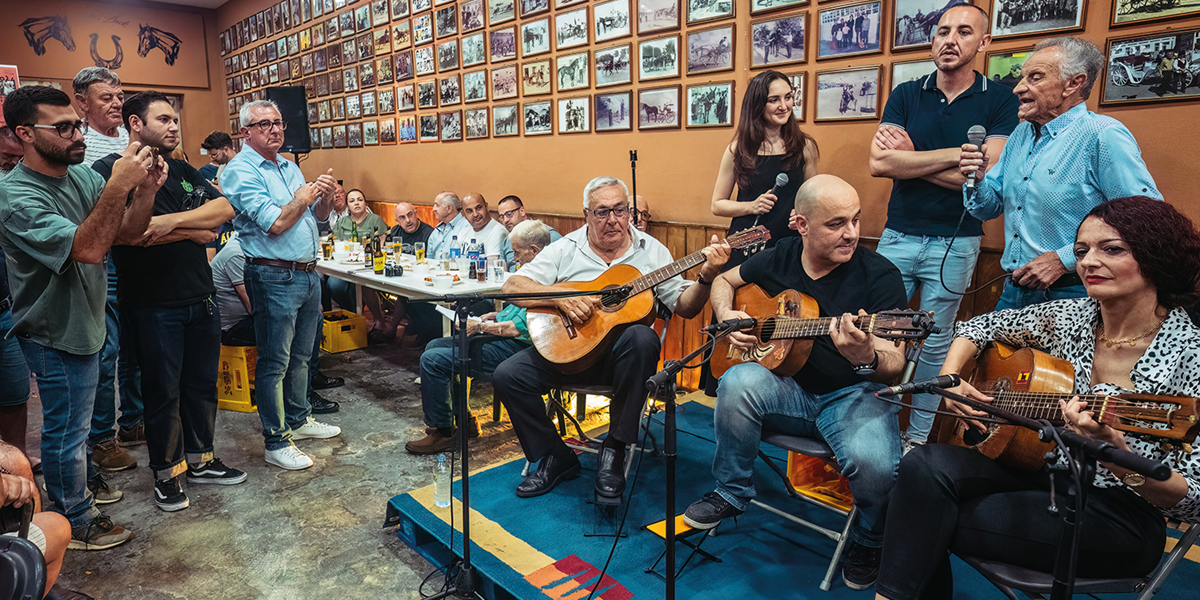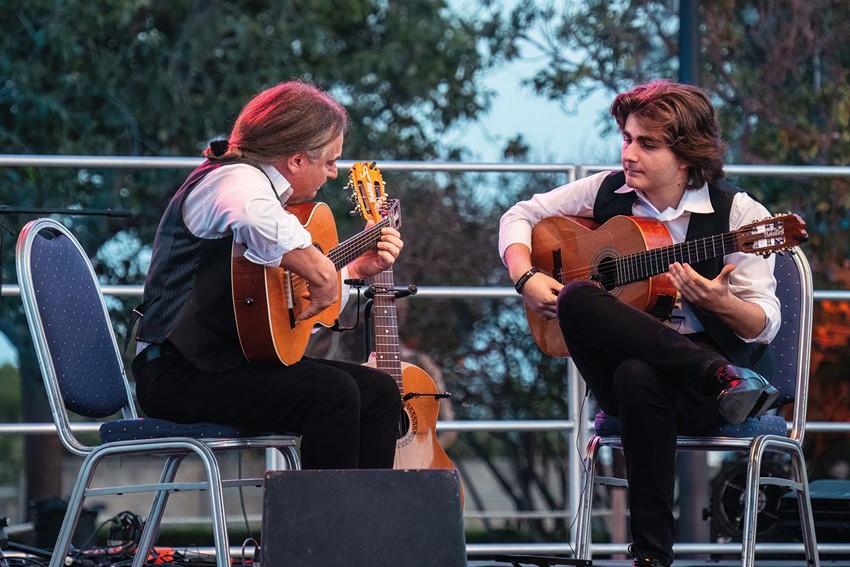Thursday, July 18, 2024
Exploring Malta's Resurgent Local Music Scene
In the centre of the Mediterranean, Malta sits between the European and Islamic worlds. That dual heritage is reflected in its Indigenous music, reports Simon Broughton, and it deserves to be better known

Performance in Mikiel Cumbo ‘L-Iżgej’’s garage
Over the soft strumming of a guitar Mariele Zammit, with flowing hair and a green dress, improvises a song in Maltese. I don’t understand the language, but with words like ‘Revolut’, ‘mobile’ and ‘batterija’ it’s clear even to me that she’s talking about a phone payment she couldn’t make because she’d run out of charge. It gets a huge laugh. That’s partly because she delivers it with a throwaway smile, but also because this very traditional Maltese form of music has been yanked into the digital age.
The music is għana (pronounced ‘aa-na’ – the għ is silent but lengthens the following ‘a’). Zammit performs briefly at an exhibition dedicated to one of the most celebrated għana singers, Frans Baldacchino (1943-2006), better known as Il-Budaj. One of the first things you need to know about għana is that every performer has a nickname by which they are much better known. One of today’s most celebrated singers, Mikiel Cumbo, is called ‘L-Iżgej’, a name that was given to his great-grandfather and which he doesn’t even know the meaning of.
Celebrated as a poet, singer and painter, Il-Budaj was the focus of this year’s Ritmu Roots Festival, an event which juxtaposes għana alongside other styles from the Mediterranean and beyond. Alongside the għana performances were musicians from southern Italy, Sicily, Crete and Estonia. The excellent Duo Ruut, two women playing one kannel (a Baltic zither), create a dynamic and engaging sound with different ways of hitting and playing the instrument, as well as vocals and electronic loops. The idea, says Andrew Alamango, għana expert, guitarist and artistic director of Ritmu Roots is “to widen the appeal of għana and show local musicians here in Malta how traditional music can be developed and revived in an innovative way.”

UNESCO added għana to its intangible cultural heritage list in 2021. The first literary mention is from 1792, although the form is much older. The UNESCO website says: ‘An integral part of Maltese culture, għana is also considered vital to the transmission and development of the unique Semitic Maltese language that reflects the Arabic, Italian and English influence on the island.’
Maltese is an extraordinary language thanks to the island’s location and history. The language is 70% Arabic and the only Semitic language written in the Latin alphabet. Malta is 280km from Tunisia and the Arabs ruled here for over 200 years, but there are also many Italian words absorbed into Maltese (Sicily is only 80km away).
Of course, the Maltese language is an obstacle for outsiders getting into għana, but language hasn’t prevented fado, flamenco, rebetika and Neapolitan song from appealing to international audiences. Malta’s population – a little over 500,000 people – is another factor, but so could be the music’s function as a social activity. Although Ritmu Roots was taking place predominantly in Malta’s capital Valletta, the heartlands of għana were in the more rural locations like Żejtun, Birkirkara and Marsaxlokk, where the music would have been typically heard in informal settings like domestic garages and clubhouses. The organisers had this in mind for one of the most ‘authentic’ evenings of Ritmu Roots, which is in Żejtun in the garage of Mikiel Cumbo ‘L-Iżgej’. The garage walls are lined with pictures of għana singers (known as għannejja), guitarists and traditional horse-drawn carriages, of which L-Iżgej is a big fan.
In the old days, before radio and TV, “at four o’clock in the village, the work was done,” L-Iżgej recalls. “We’d pull up a chair, guys would get the guitars and there was nothing else to do. It was a social thing – to enjoy being together and relax. Please get the guitars going because I have something to say…”
‘How sweet the sound of guitars / How sweet they sound at night / They wake those who are sleeping / And stop those who pass by.’
Many of the lyrics are like Japanese haiku. There are four main types of għana music. The most popular is spirtu pront – derived from ‘quick-witted’ in Italian – in which singers alternate improvised quatrains to compete with each other. The four lines have A-B-C-B rhymes with lines alternating eight and seven syllables. In between are guitar breaks with the kitarra tal akkumpanjament playing plucked chords and a prim guitar playing a solo melody alternating with the voice. In Ritmu Roots four singers were singing spirtu pront in the Argotti Gardens, a lovely location in Floriana, in which singer one would be answered by singer three and singer two answered by singer four, creating an interesting vocal choreography. Some of the verses got chuckles, but nothing like as much as Mariele Zammit with her mobile phone lyrics.
Another type of għana is għana tal-fatt. ‘Fatt’ means facts and in the past, these might have been news stories of the day, but the preserved ones are historical epics about Toni Bajada, a hero of the Great Siege of 1565 when around 9,000 Maltese stood up to the Ottoman navy of 30,000 men. In the siege, as in World War II, Malta played a crucial defensive role.
The third form is għana tal-makkjeta, a jokey style usually accompanied on the guitar by major chords, and finally għana fil-gholi, which means ‘high-pitched’ and is also known as la Bormliża. Here, the singer uses a high, slightly strangulated voice, but once you get accustomed, it is rather beguiling. “The verses are poetic in nature,” says Alamango. “It’s not so much about the words, but how you embellish them with ornaments or ksur [inflections].” Sometimes the lyrics aren’t really audible, so it’s perhaps the most exportable form of għana.
L-Iżgej has been mentoring Mariele Zammit in the high-pitched għana for several years and, aged 32, she’s become one of għana’s bright young hopes. She trained as a jazz singer – and still sings in that style – but was introduced to għana for a theatre piece. “I remember listening to L-Iżgej for the first time and thinking ‘Oh my goodness, is this Maltese?’,” she says. “I could feel a connection and a sense of pride. I thought how beautiful this is and I wanted to keep meeting him every week, even after the theatre piece was over. So, for my għana singing it was just the beginning.”
Is it an ambition to try and revive the music? “It’s not about reviving it because it’s still alive in its context,” she says, “but we can widen the audience. It’s also what Il-Budaj tried to do. He used to say ‘I want to remove it from the corners of the shops.’ But he didn’t live long enough to see it happening. So what interests me is the wide spectrum of people who can attend an event like this.”
The epic song about Toni Bajada was among the first recordings of Maltese musicians made in Milan between 1931 and 1932 for HMV. These 38 pieces, now digitised by Andrew Alamango and released on CD, vinyl and online via his Filfla Records label, were sung by Emmanuele Cilia ‘Ta’ Napuljun’ (Napoleon-like) and, on the 1932 tracks, accompanied by guitarist Carmelo Cardona ‘It-Tapp’ (Shorty). Shorty did much to improve the quality and sophistication of għana guitar playing, just as Armandinho did with Portuguese guitar in fado, and his influence is preserved in the music of father-and-son duo George and Karol Aquilina ‘Ta’ Nofsillejl’ (Midnight) who accompany the għannejja in the festival. Karol Aquilina, playing prim guitar, adds very impressive improvisations.
“Cilia’s recordings went on selling into the 1960s when D’Amato Records (who had organised the 1930s recording trips) re-released 25 of the most popular tracks as 45rpm discs which were played on the radio and remain in the collective memory of people today,” says Alamango. Curiously the large-scale emigration that took place post-WWII – many Maltese moved to Australia and Canada – helped to reinforce the għana tradition. “Those outside the country felt the need to keep in contact with those at home,” explains Alamango. “When reel-to-reel tapes arrived they would send recordings of song sessions and guitar playing back and forth which kept the art going.”
The fact that there’s always been a loyal public in Malta is evident in Żejtun, one of the homes of għana where there’s a public park with statues of singers born in the town. One of the statues is of Il-Budaj with his guitar, though the fact that several letters have literally dropped off the plaque under the memorial suggests there’s still work to be done.
Ritmu Roots Festival takes place every May in Malta, next year’s is scheduled for May 16-24
This article originally appeared in the August/September 2024 issue of Songlines. Never miss an issue – subscribe today

